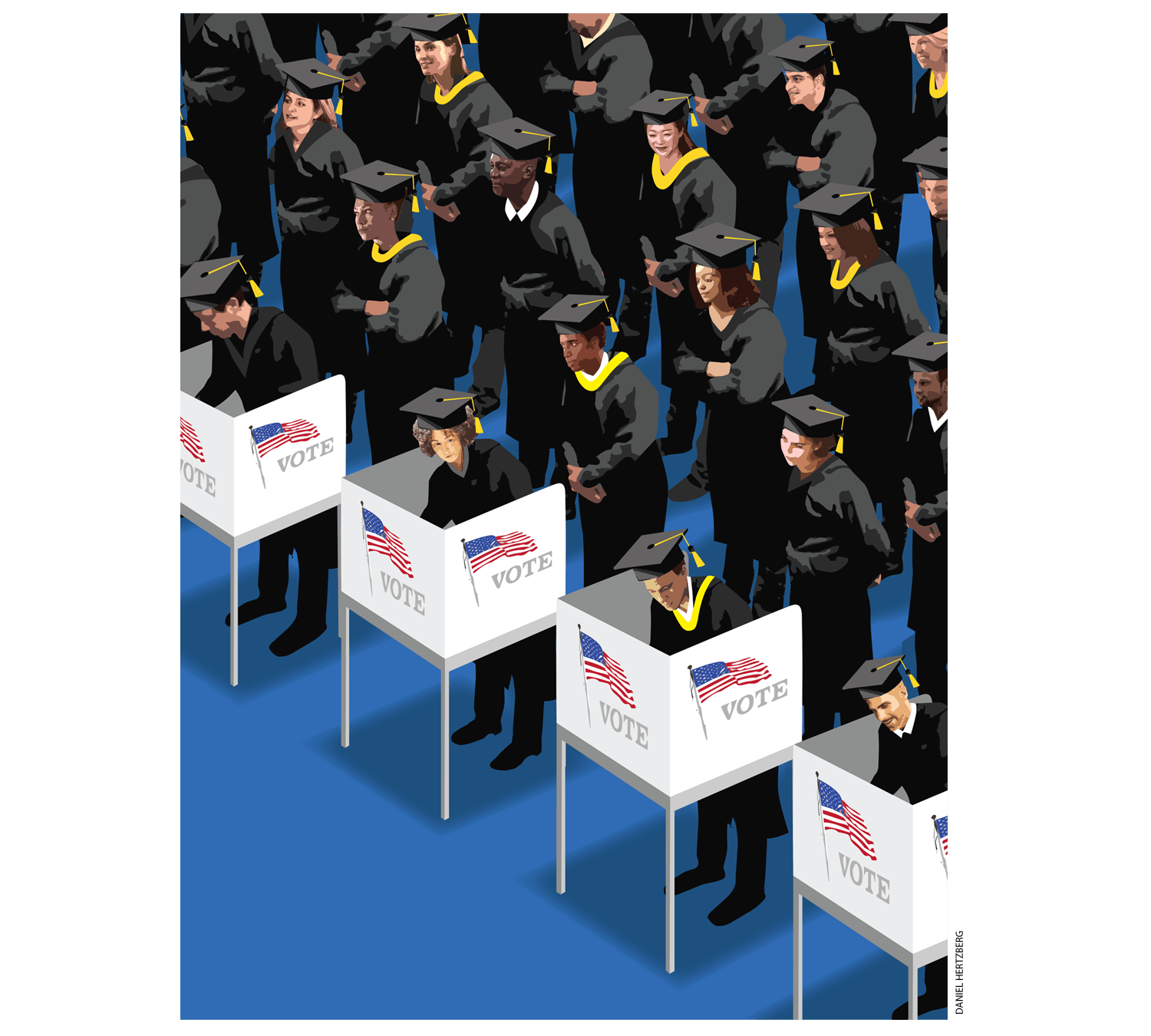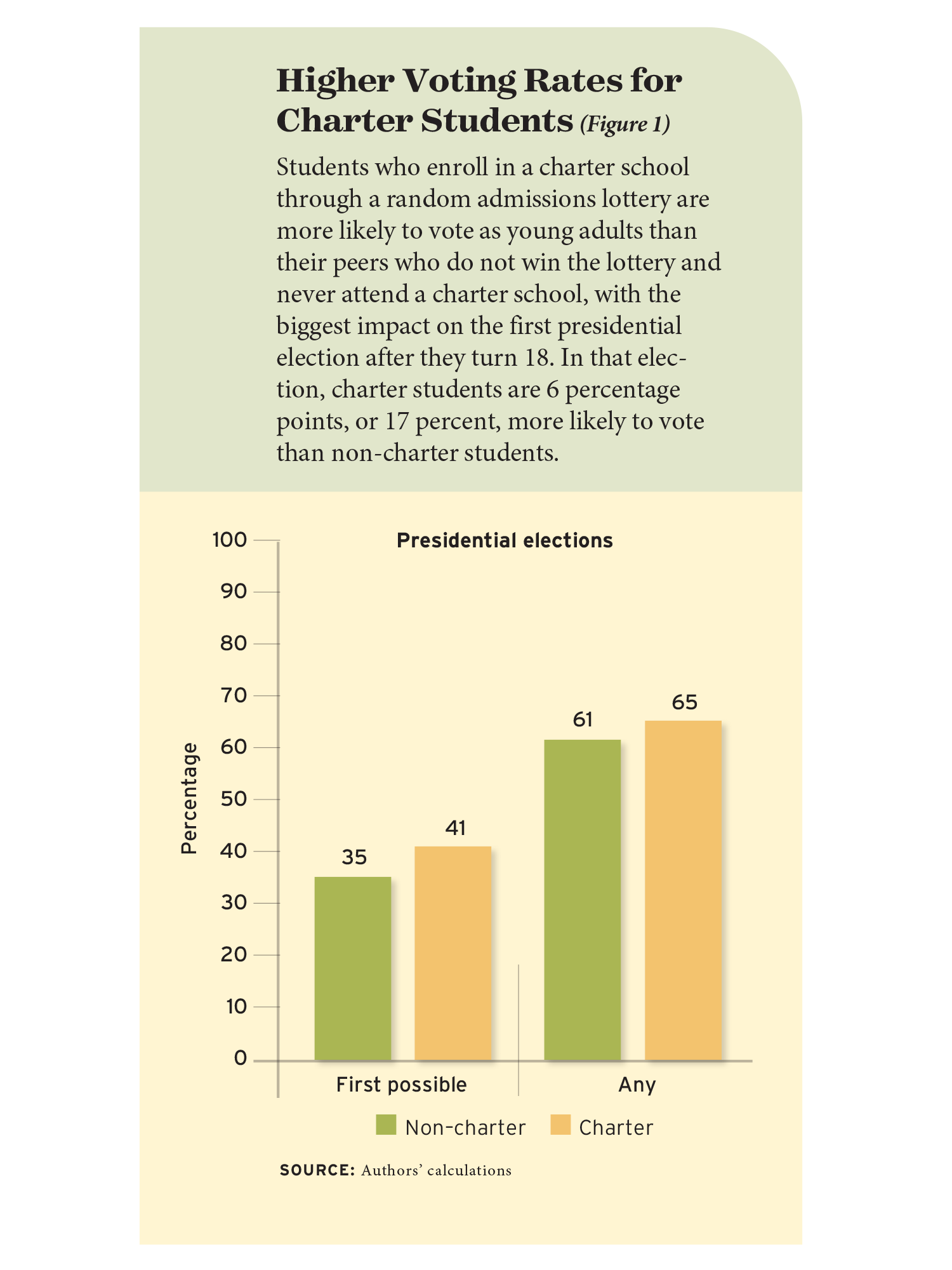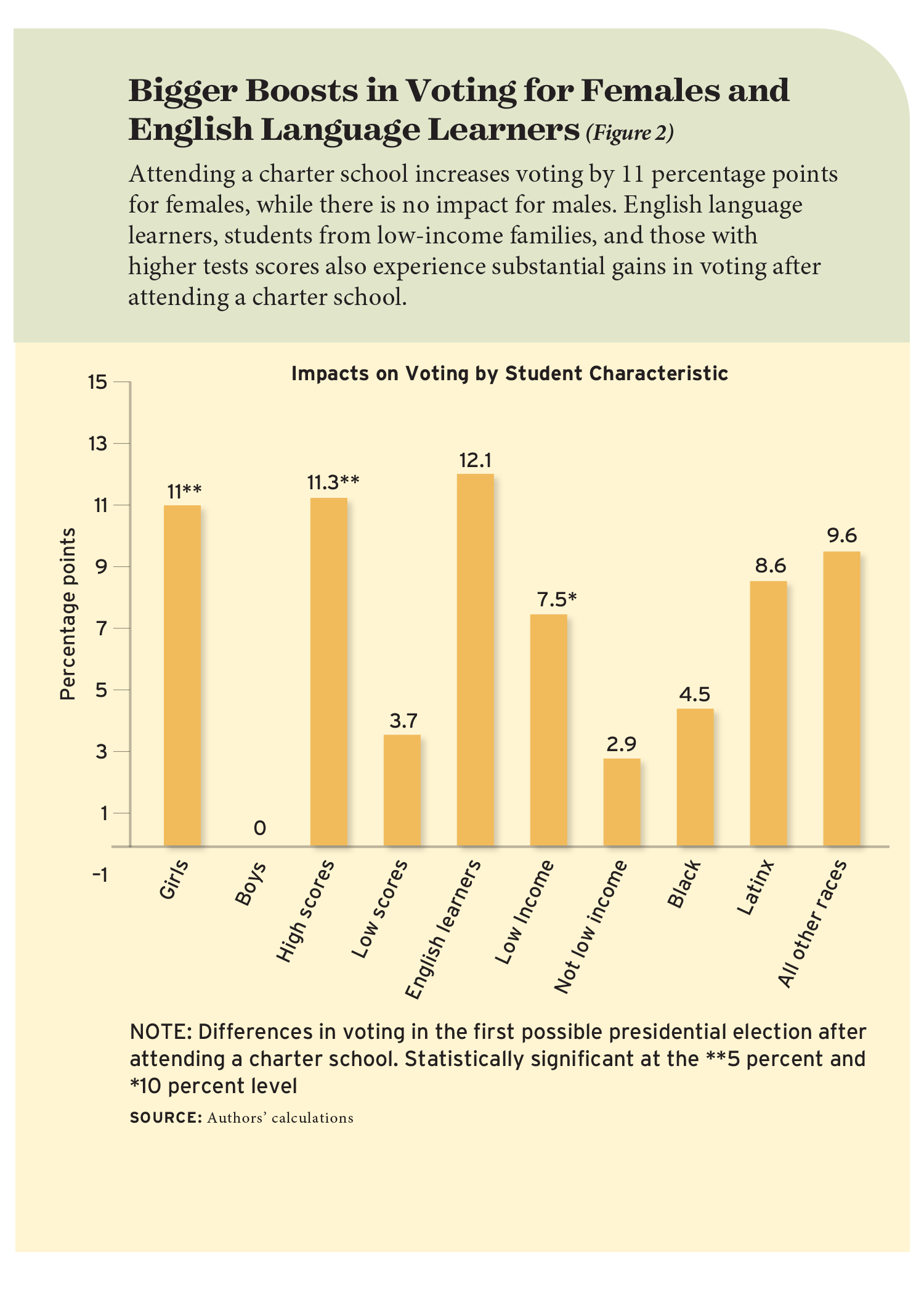
Americans with more education vote at higher rates. In the 2020 presidential election, 77 percent of eligible voters who had attended or graduated from college and 90 percent with post-graduate studies cast a ballot compared to 54 percent of voters with only a high-school diploma and 36 percent of dropouts. These trends in turnout rates have persisted for more than three decades, suggesting a link between years of schooling and voting. But does achieving higher levels of education cause citizens to show up and vote on election day? Or do education and voting simply go hand-in-hand, because some other variable contributes to them both?
The research to date is mixed. Some studies have found evidence of a causal relationship, while others have not. The available data also tell us little about why and how education increases voting.
We take on these questions by looking at the educational trajectories and adult voting records of students who attend charter schools in Boston. We focus on Boston because prior research has found that students who attend a city charter are more likely to pass high-school exit exams, have higher test scores, and are more likely to attend a four-year college than their non-charter peers. Further, because Boston charters are oversubscribed and enroll students based on random admissions lotteries, we can compare charter students, who receive more education, with similar students who did not win a lottery and therefore receive less education. If education is a causal factor in voting, we’d expect to find that the students who experience these academic gains are also more likely to vote as adults.
That is, in fact, what we find—but only for girls. We look at the voting records of charter and non-charter students and find substantial differences. While similar shares of charter and non-charter students are registered to vote by age 21, charter-school students are slightly more likely to vote in any election and substantially more likely to vote in the first presidential election for which they are eligible. Specifically, 41 percent of all charter-school students vote in their first presidential election compared to 35 percent of students who did not attend a charter, an increase of 17 percent.
When we look more closely at the data, we see that the charter effect is a female phenomenon. Female high-school students are 11 percentage points more likely to vote in adulthood if they attended a charter school, while the impact for males is nil. We investigate multiple explanations for these differences and find that increased civic participation is likely due to gains in noncognitive attributes like grit and self-control, which we measure by looking at student behaviors, such as school attendance and taking the SAT.
These findings are in line with widening gender gaps in educational attainment and political participation. In 2020, 82 percent of eligible women voted in the presidential election compared to 73 percent of eligible men. Meanwhile, in 2021 some 39 percent of women ages 25 and older had a bachelor’s degree compared to 37 percent of men, and males currently account for just 42 percent of all students at four-year colleges. Our research sheds new light on these patterns and points to a critical question for future study. What can schools do to enhance non-cognitive skills development in boys, and what intervention could boost civic participation in young men after graduation?
Academic Success at Boston Charter Schools
Charter schools are public schools, funded with public money, but managed by private organizations. In Massachusetts, the state board of elementary and secondary education authorizes charter schools for five-year terms, and for-profit charter operators are not permitted. State law caps the share of district funds that can be used for charter tuition, with limited flexibility. If a school cannot enroll all interested students, they conduct a random admissions lottery, enroll the winners, and place students who did not win on a waitlist. For the 2023-24 school year, some 76 charter schools statewide enrolled about 46,000 students, and 66 of those schools had waitlists with another 21,270 unique students.
Boston has the highest concentration of charter schools in the state. Most use policies associated with the “No Excuses” charter school movement: longer school days and years, a focus on academic achievement and behavior management, in-school tutoring, frequent teacher feedback, and data-driven instruction. Prior research has found that attending a Boston charter school for one year boosts student scores on standardized tests by about one-third of a standard deviation in math and one-fifth of a standard deviation in reading. These findings are generally in line with studies of similar charter schools in Chicago, Denver, Los Angeles, New York City, Newark, New Orleans, and the national non-profit KIPP network.
Our study looks at the voting behavior of young adults who applied to a randomized admissions lottery for a Boston charter high school. We include all charter middle and high schools that kept lottery records and enrolled students who were at least 18 by the 2016 general election. In all, that includes 12 charter schools and 9,562 lottery applicants who were scheduled to graduate between 2006 to 2017. The applicant pool is 58 percent Black, 27 percent Hispanic, and 10 percent white. About 20 percent receive special-education services and 74 percent qualify for free or reduced-price school lunch. Females account for 52 percent of applicants.
Through the lotteries, about two-thirds of applicants are offered a charter seat. This creates a natural experiment that we use to explore the potential causal link between charter-school attendance, which boosts academic scores and access to college, and voting. We use state education and voting records to compare academic outcomes and election turnout for students who are and are not offered a charter seat and adjust our estimates based on who actually attends a charter school. We do not include siblings of current students or other applicants who receive lottery preferences. Of course, not all students offered seats attend the charter; however, state data show that applicants who win the lottery are 46 percentage points more likely to attend a charter during their time in Massachusetts public schools. We also see that boys and girls are equally as likely to enroll in a charter school if offered a seat.
Linking Learning with Voting
First, we benchmark the impact of charter attendance on academic outcomes against results from prior research. As in other analyses, we find that students who enroll in a charter school experience large gains in AP test-taking and scores, SAT scores, and four-year college enrollment. On state tests, scores increase by about half of a standard deviation in math and one-third of a standard deviation in reading two years after winning an admissions lottery. Charter students take longer to graduate high school, with a decline of 9 percentage points in the four-year graduation rate, but there are no statistically significant differences in five- or six-year high school graduation rates. Boston charters boost enrollment in four-year colleges by 7.2 percentage points.
We then investigate whether these educational gains extend beyond the classroom to civic participation. We find no impact on voter registration—about 78 percent of students in both groups are registered to vote by age 21, with about 45 percent of students registered by their 19th birthday. However, we do find differences in voter turnout. We focus on the first possible presidential election after students turn 18 to leave less time for them to leave Massachusetts or the region, and thus our sample. Additionally, the first possible presidential election is the election closest to the charter school treatment, which we believe is most likely to show the influence of attendance.
Charter-school students are more likely to vote than non-charter students, with the biggest difference in the first presidential election in which they are eligible to vote (see Figure 1). Some 41 percent of charter students vote in the first presidential election after they turn 18 compared to 35 percent of non-charter students, a difference of 17 percent. Charter students are also more likely to vote in any presidential election, with turnout at 65 percent compared to 61 percent for non-charter students. In looking at all opportunities to vote, including off-cycle elections where turnout is generally very low, we find a difference of 3 percentage points, with 67 percent of charter students voting compared to 64 percent of non-charter students, though the difference is not statistically significant.

We also look at voting by student subgroups and find that female charter students experience outsized gains (see Figure 2). In terms of voting in the first possible presidential election, the charter impact is 11 percentage points for girls and zero for boys. We also find meaningful effects for other student subgroups. Voting increases by 7.5 percentage points for students who receive free or reduced-price school lunch, 12.1 percentage points for English language learners, and 11.3 percentage points for students who earn relatively higher scores on state tests.

“Soft Skills” and the Ballot Box
Our findings show that charter schools boost academic outcomes and civic participation. That raises a second question: how? What aspects of education contribute to students’ likelihood to vote as adults?
We look at five possible explanations of why education may increase voting: development of cognitive skills, civic skills, social networks, the degree to which charter attendance politicizes students, and noncognitive skills. Our finding of a gender gap in voting allows us to identify proxies for these mechanisms and test the impact of each one. If the gender gap we find in voting is also present on a proxy measure, that mechanism is the most likely to explain increased civic participation among female charter school graduates.
For example, to assess whether increased cognitive skills help explain why citizens with more education are more likely to vote, we compare the impact of charter attendance on average test scores in reading and math for the males and females in our sample. Both genders experience the same large increase in math scores, while the positive impact in reading is slightly bigger for males. Since these impacts do not mirror the female-only effect of attending a charter school on voting, cognitive skill development does not appear to influence civic participation. More knowledge doesn’t necessarily beget more voting.
We conduct similar analyses of proxies for the other four mechanisms and find evidence that development in one area appears to explain charters’ impact on voting: noncognitive skills. While our data do not include a direct measure of noncognitive skills, such as a survey-based measure of self-control or grit, we use high-school attendance and taking the SAT as a proxies, since they are related to persistence and follow-through. This approach builds on prior research and captures some of the attitudes and behaviors students would draw on in order to vote, as voting in the U.S. often involves navigating sign-up processes, planning ahead, and following through.
Overall, students at charter schools attend 12 additional days of school from grades 9-12 compared to non-charter students. However, this effect is driven entirely by girls. Female charter students attend 22 additional days of school compared to non-charter females, while charter males do not attend school more regularly than their non-charter counterparts. We find similar, but not statistically significant, differences in SAT taking: charter females are 8 percentage points more likely to take the SAT than non-charter females, while the effect of charter attendance for males is just 2 percentage points.
This evidence cannot prove that stronger noncognitive skills cause a boost in voting. But taken together, we see that charters appear to shift noncognitive skills more for girls than boys, and that these differences align with the observed pattern in voting gains. Further, the gender gap in noncognitive skill gains we observe is consistent with prior research. Studies have shown that girls enter kindergarten with greater noncognitive skills than boys, maintain their advantage through elementary school, and have greater self-discipline than boys in 8th grade. Other research has found that these differences explain 40 percent of the gender gap in college attendance. There is also research showing that girls may gain more noncognitive skills from educational interventions, and that conscientiousness and emotional stability increase voter turnout for women, but not men. Thus, girls—perhaps because of socialization—are more likely to turn gains in noncognitive skills into voting.
Although our study finds the main beneficiaries of civic gains are young women, education’s contribution to voting need not operate solely through girls. Interventions that increase noncognitive skills for boys may have similar effects, though we do not observe them in this context. It is also possible that U.S. schools, and charter schools specifically, are set up in such a way that they particularly develop the skills of girls but not boys. Research to date has mainly focused on the overall impact of noncognitive skill development through social and emotional learning programs or documented longstanding gender gaps in this arena. Interventions that boost noncognitive skill development and other lagging outcomes in boys (see “Give Boys an Extra Year of School,” reviews, Spring 2023) or school curricula that specifically target civic engagement (see “A Life Lesson in Civics,” research, Summer 2019) are areas ripe for further study.
Sarah R. Cohodes is associate professor at the Gerald R. Ford School of Public Policy at the University of Michigan. James J. Feigenbaum is assistant professor at Boston University.
This article appeared in the Summer 2024 issue of Education Next. Suggested citation format:
Cohodes, S.R., and Feigenbaum, J.J. (2024). Why Education Increases Voting: Evidence from Boston charter schools. Education Next, 24(3), 60-65.


